- The CMOS Technology
50.002 Computation Structures
Information Systems Technology and Design
Singapore University of Technology and Design
The CMOS Technology
Overview
Recall that the ideal behaviors and characteristics of a combinational logic device are:
- The device should be able to tolerate some amount of errors due to its Noise Margins. The Noise Margin exists if its VTC gain $>1$.
- If we have high gain, that means we can have more noise margin.
Take some time to convince yourself that this is true.
- The device should be cheap, and small sized.
We do not want to have bulky devices, do we?
-
The device should have zero power dissipation when input voltages aren’t changing. That’s why the device must have a nonlinear gain.
- Otherwise when voltage is changing from,
0to1or1to0, then power within the device has to dissipate easily.Meaning that the change is swift is and quick
- The device has to be functional, meaning that it conforms to the assigned truth table (logic) at all times.
We do not want unpredictable behavior with our devices.
In this chapter, we are learning a particular component called the MOSFET that can be used as a building block for our combinational logic device. It has all the characteristics mentioned above.
The MOSFET
Metal-oxide semiconductor field effect transistors (MOSFET, or shortened as FETs) is the main material that is used to make our combinational device. The basic schematic of a transistor is shown in the figure below.
MOSFETS are four terminal voltage-controlled switches.
Current flows between the diffusion terminals (source and drain) if the voltage on the gate terminal is large enough to create a conducting channel (in pink) and the mosfet is on. Otherwise, the conducting channel does not form and the mosfet is off: the diffusion terminals are not connected.
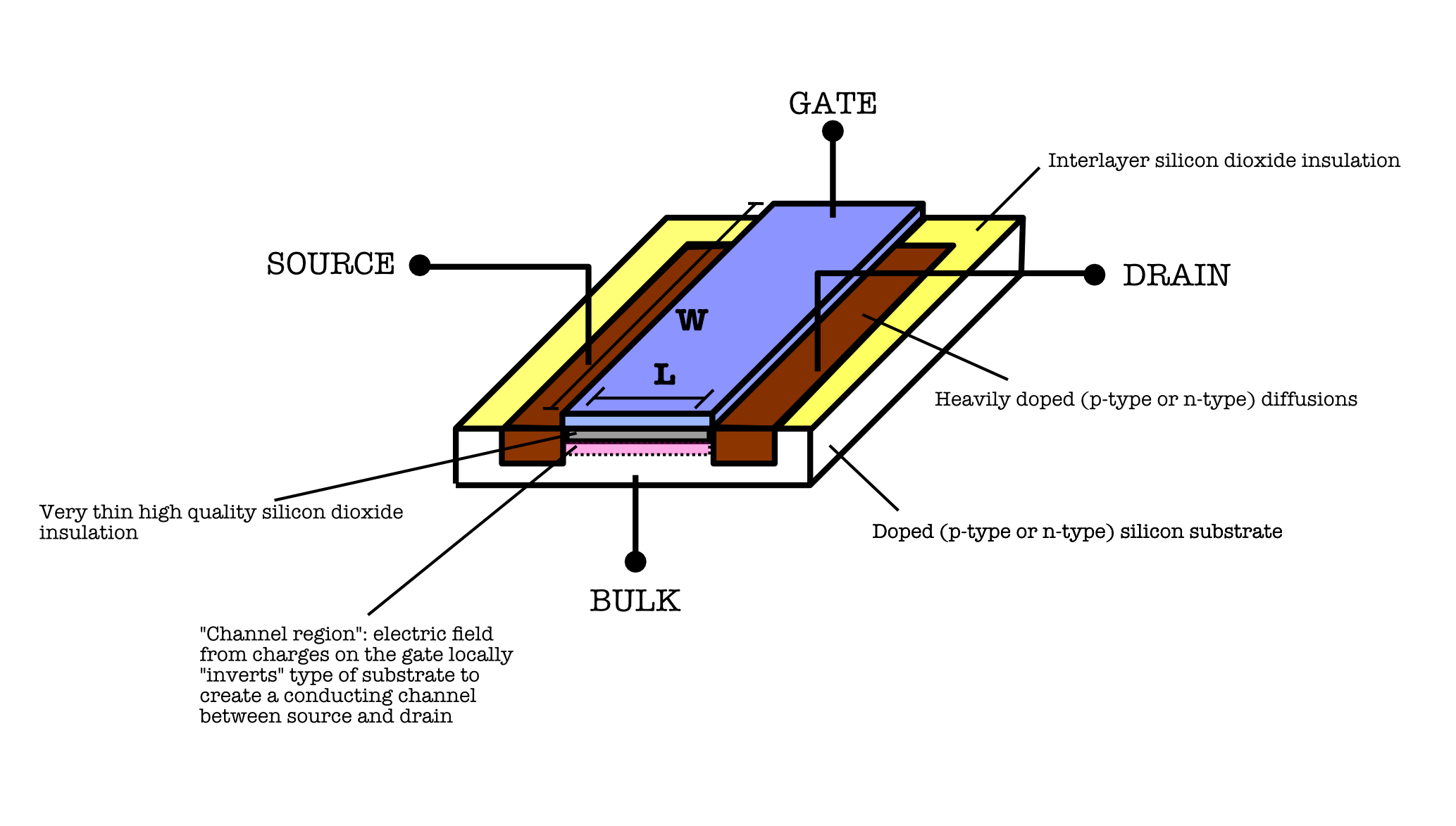
Notable parts of MOSFET and its function:
-
MOSFETs are devices that are used to ‘switch’ 1s to 0s (high voltage to low voltage) and vice versa, so that we can implement functionalities (truth table or logics)
-
It has 4 terminals. Input is supplied at the gate, and output is obtained at the drain.
-
The current flow between source and drain $I_{DS}$ is proportional to $\frac{W}{L}$ (the width and the length) of the MOSFET.
-
Source and drain is physically symmetrical, we name them depending on the type of the MOSFET.
Some basic recap before we move on:
Current flows from higher potential (+) to lower potential (-) Electron flows from lower potential (-) to higher potential (+)
Types of MOSFETs
If we connect these MOSFETs connected in a specific way, we can create a combinational logic device that represents our desired truth table or functional logic specification But before we learn how to create such devices, we need to learn two basic types of MOSFETs first.
There are two types of FETs: the NFET and the PFET.
-
The NFET : the majority of the charge carrier for the bulk are holes (p-type semiconductor). The majority of the charge carrier for the source and drain are electrons (n-type semiconductor). Typically, the bulk is connected to GND to keep the PN junction reverse biased.
Please watch the pre-preading video or refer to the later section if you are unclear about what is a PN junction, p-type, or n-type semiconductors.
-
The PFET : the majority of the charge carrier for the bulk are electrons (n-type semiconductor). The majority of the charge carrier for the source and drain are holes (p-type semiconductor). Typically, the bulk is connected to
VDDto keep the PN junction reverse biased
Some terms we need to set straight before we proceed:
VDD: voltage source- $V_{TH}$: threshold voltage.
GND: ground- Reverse-biased: a state whereby D is insulated from S, where current cannot flow from D to S in the presence of applied voltage.
- A FET that is “ON” refers to a state whereby there exists a connection between D and S, so that current can flow through them.
- A FET that is “OFF” referes to a state whereby there is no connection between D and S. Current cannot flow through them.
The circuit symbol for NFET and PFET are shown as below. Note that the bulk of NFET is connected to GND, and the bulk of PFET is connected to VDD.
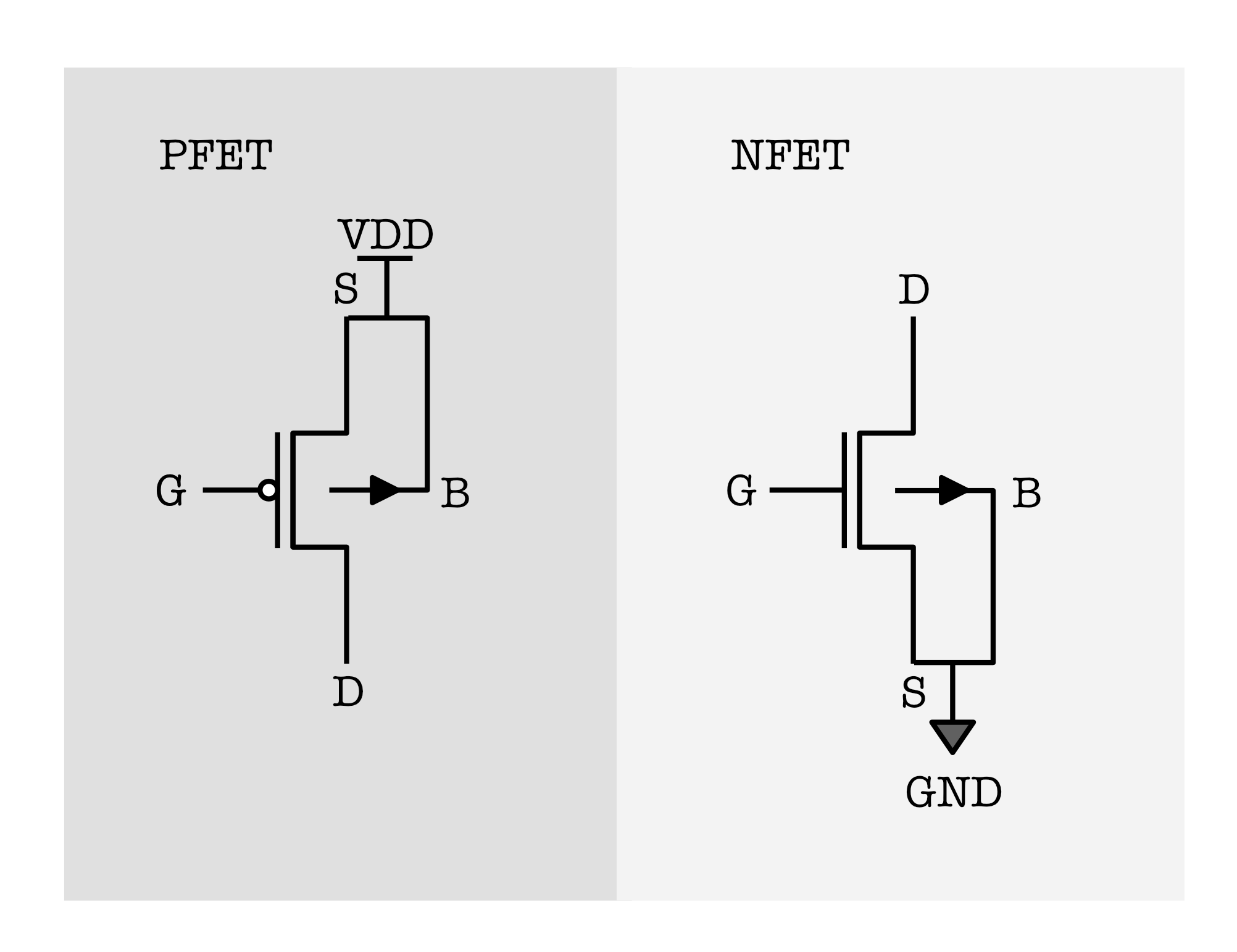
Switching NFETs and PFETs ON/OFF
See the figure below and its corresponding explanation to understand better how NFET and PFET operates. The two drawings on top are PFETS (left: OFF and right: ON). The two drawings below are NFETS (left: OFF and right: ON). You might want to refer to this Figure as well when reading the Supplementary Sections below.
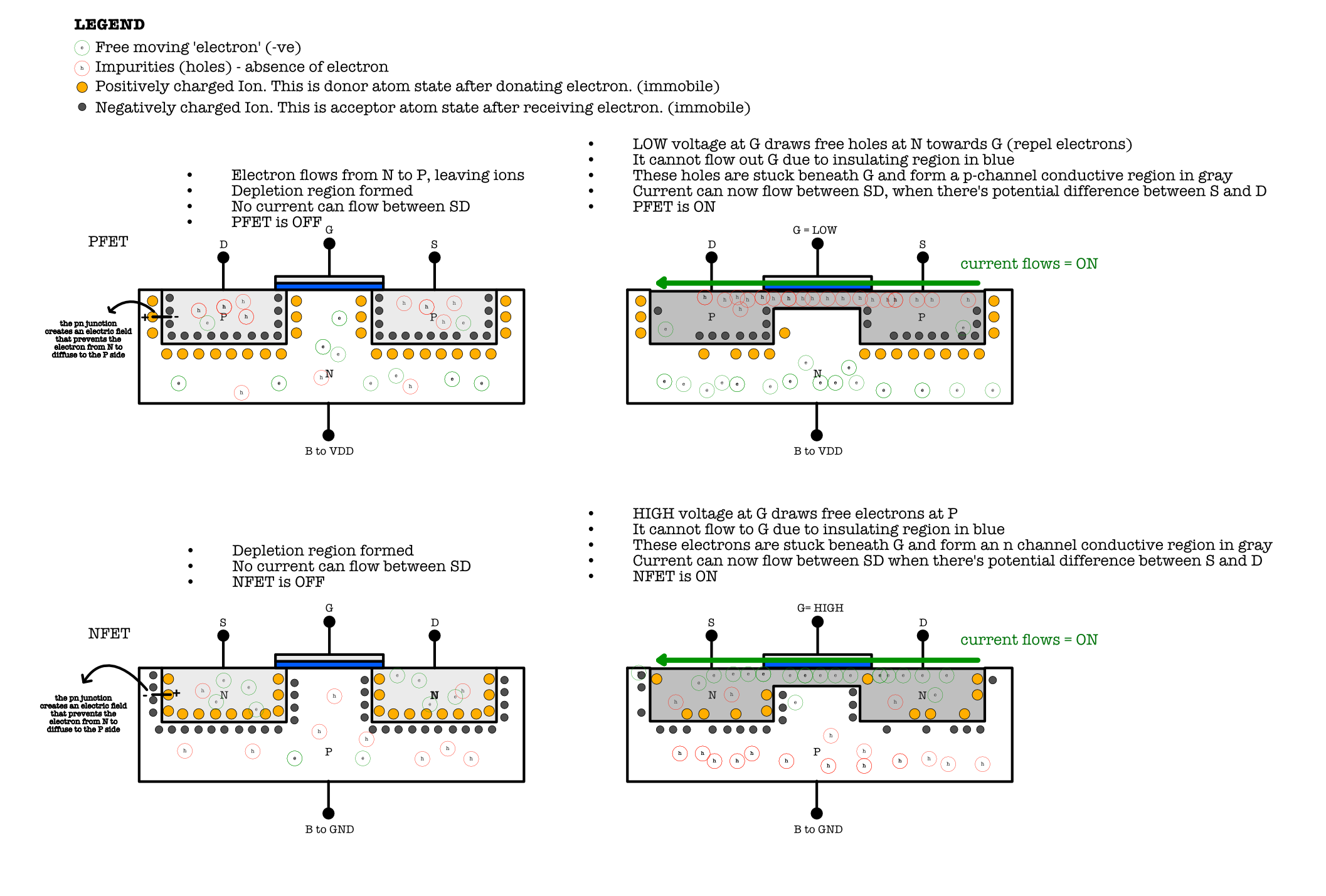
How NFET operates:
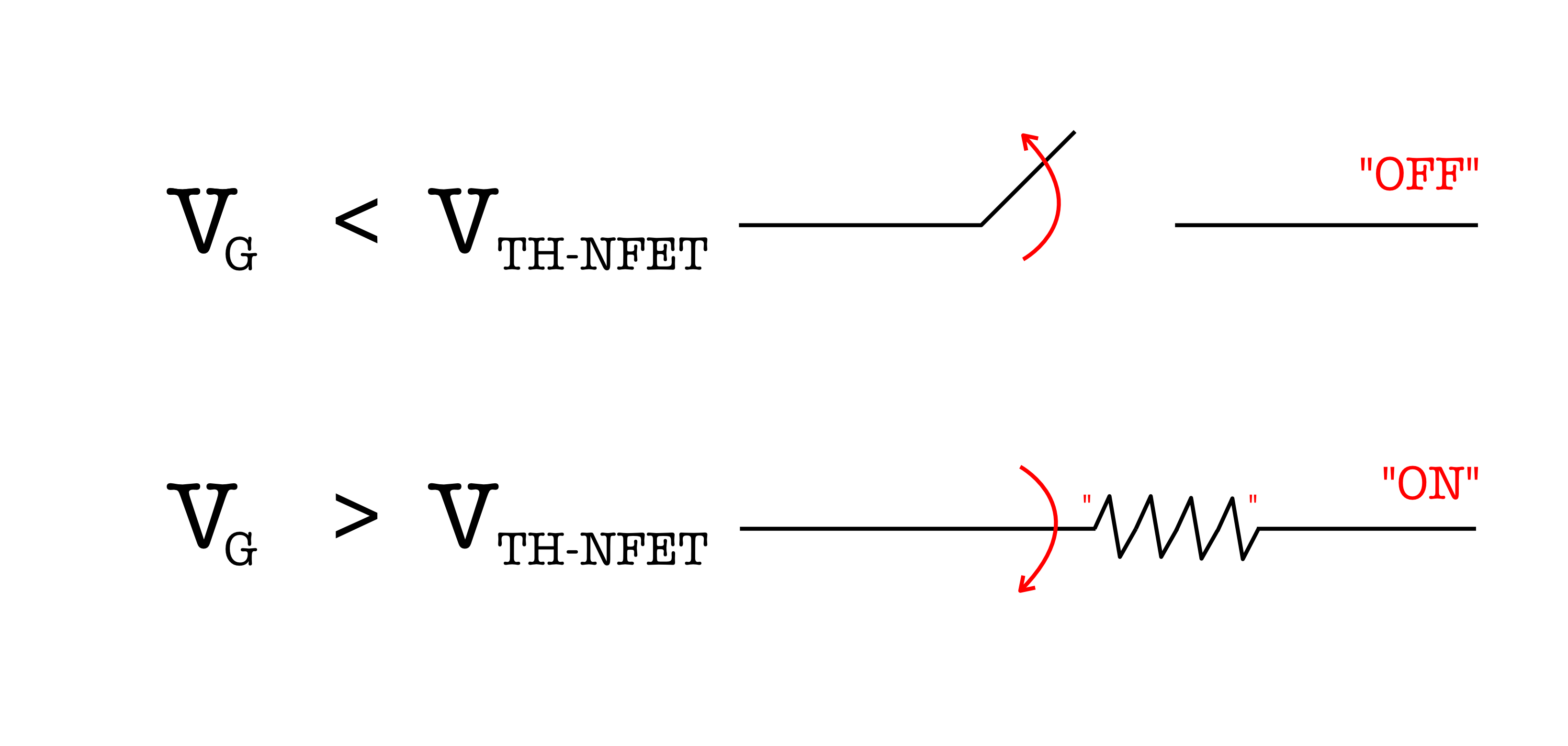
- Connections:
- Bulk is connected to
GNDto keep the PN junction reverse biased, meaning that no current should flow or leak between source and bulk and between drain and bulk. - S (and also bulk) is connected to
GNDfor NFET. Current from D is therefore drained toGNDconnected to S.
- Bulk is connected to
- It is “ON” when $V_{GS} = V_G - V_S$ is high enough. Since source terminal is connected to the
GNDfor NFET,- $V_{GS} = V_G - 0 = V_G$,
- the NFET is "ON" whenever $V_G$ is high enough, i.e: $> V_{TH}$.
- When $V_G > V_{TH}$, it draws the electrons towards the gate. An n-channel (made of electrons) will be formed between source and drain.
- Note that $V_{TH}$ for NFET is positive.
- When it is "ON", current can pass from D to S.
- Electrons, its majority charge carrier flows from S to D
We can say that its majority charge carrier is drained at D.
- The output of an NFET is at the D terminal.
- Hence, the output of an "ON" N-type is ‘0’
- Electrons, its majority charge carrier flows from S to D
- It is "OFF" when \(V_{GS}\) is low, as it encourages depletion region to form further.
How PFET operates:
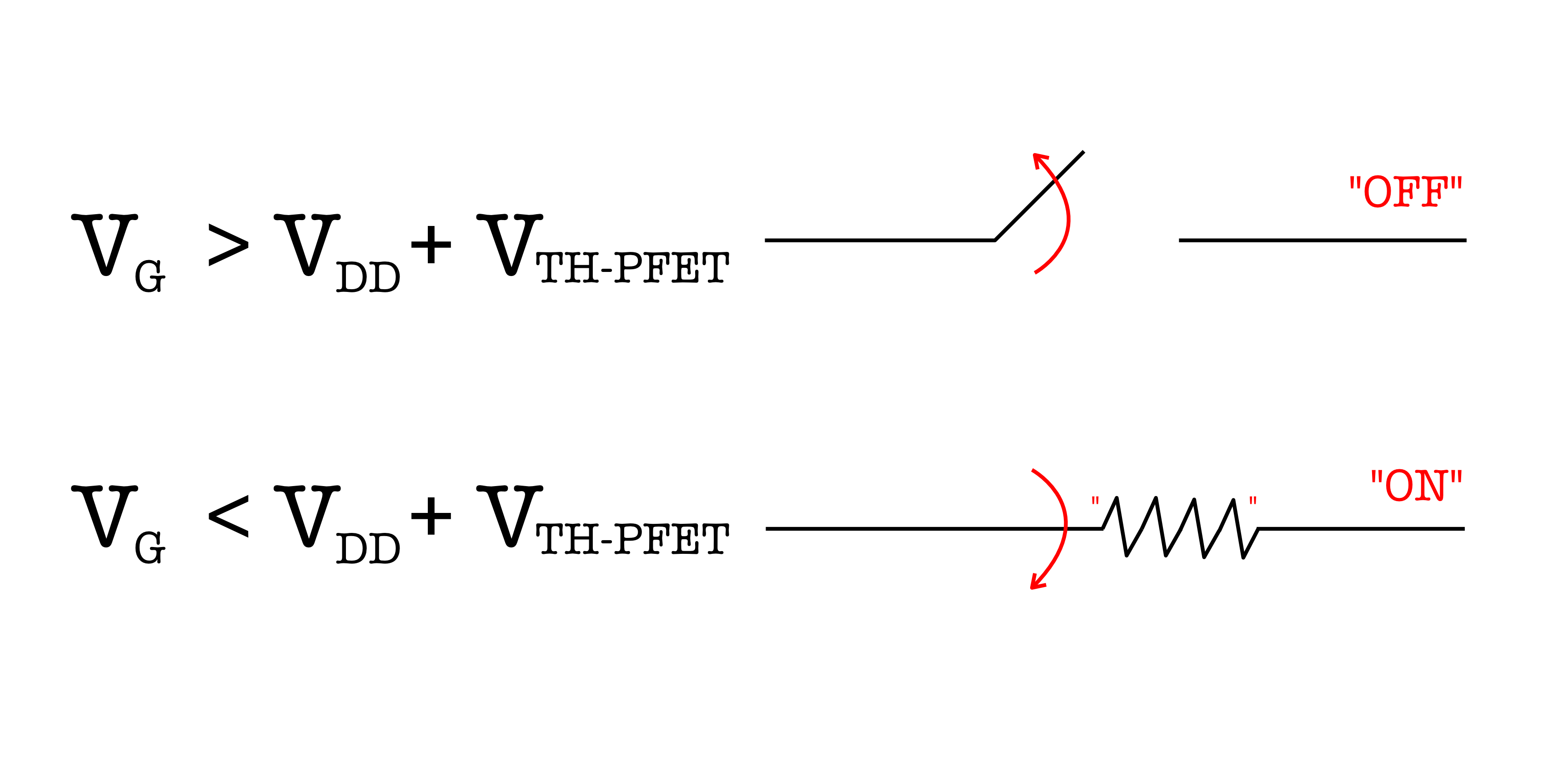
- The PFET symbol is similar to NFET except that it has the by the bubble $\circ$.
- Conversely,
- Bulk is connected to
VDDto keep the PN junction reverse biased, meaning that no current should flow or leak between source and bulk and between drain and bulk. - S (and also bulk) is connected to
VDDfor PFET. Current can flow from S to D.
- Bulk is connected to
- It is “ON” when $V_{GS}$ is low enough. Since source terminal is connected to
VDDfor PFET,- $V_{GS} = V_G - VDD$,
- Hence effectively PFET is "ON" whenever $V_G - VDD$ is low enough, i.e: $< V_{TH}$.
- When \(V_G < `VDD` + V_{TH}\) (or equivalently, \(V_{GS} < V_{TH}\)), it draws the holes towards the gate. A p-channel (made of holes) will be formed between source and drain.
- Note that $V_{TH}$ for PFET is negative.
- When it is "ON", current can pass from S to D.
- Holes, its majority charge carrier flows from S to D.
We can say that its majority charge carrier is drained at D.
- The output of an PFET is also at the D terminal.
- Hence, the output of an "ON" p-type is ‘1’
- Holes, its majority charge carrier flows from S to D.
- It is “OFF” when $V_{GS}$ is high, as it encourages depletion region to form further.
In summary:
MOSFETs operates using voltages. No current flows from the gate towards source/drain since the gate is insulated from source and drain. This is unlike common (cheaper) PNP and NPN transistor (standard bipolar junction transistor – BJT) that operates using current. The “output” that we get at the drain of either PFET or NFET is a result of the connection between Source and Drain due to the presence / absence of voltage in the gate.
Supplementary Sections
Please refer to this section if you have not already understand about p-type and n-type semiconductors, PN junction, and source-drain terminal naming.
P-type and N-type Semiconductors
Not to be confused with PFET and NFET.
In the p-type semiconductor there are plenty of acceptor atoms and in the n-type semiconductor there are plenty of extra electrons (donor atoms). We can say that a p-type region is where the majority of the carriers are holes and an n-type region is where the majority of the carriers are electrons.
To be precise, an electron is one of the constituents of an atom, having a negative charge. An acceptor atom has for example 3 electrons in valence shell and can accept one electron to complete the covalent bonding. Thus it gains one extra electron and acquires negative charge. On the other hand, a donor atom has 5 electrons (one extra) in valence shell and can donate one extra electron. It thus acquires unit positive charge in the process.
Depletion Region
When p-type and n-type semiconductors are placed together, the free electrons from n-type will flow over (diffuse) to the p-type and fill its holes (impurities). Filling up a hole results in a negatively charged ion at the p-type semiconductor, as illustrated as the gray circles in Figure above. Equally, these free electrons leaving the n-type leaves behind a positively charged ion at the n-type semiconductor. This is illustrated as the yellow circles.
Eventually, a space-charge builds up forming an electric field as denoted in the left drawings (the yellow circles and the grey circles form electric field), preventing more free electrons from the n-type side to the p-type side, thereby forming an insulating layer called depletion region.
P-channel or N-channel Formation
For NFETs, when there’s presence of high (positive) voltage at the gate, it repels the extra holes at the p-type bulk. Basically, a positive voltage applied to the gate attracts electrons (which are minority in the p-type substrate) to the interface between the gate dielectric and the two n-types semiconductors (drain and source).
These electrons form a conducting n-type channel between the source and the drain, called the inversion layer. When there’s potential difference between the drain and the source, the current will flow from source to drain through this inversion layer.
For PFETs the opposite happens. When there’s presence of low (negative) voltage at the gate, it repels the extra electrons at the n-type bulk. Basically, holes (which are minority in the n-type substrate) are the majority in the region between the gate dielectric and the two p-types semiconductors, forming a conducting p-type channel (inversion layer). When there’s potential difference between drain and source, then the current will flow from source to drain through this inversion layer.
Note that the position of the source and drain in PFET is switched , compared to what is depicted for NFET. Read the next section for details.
Naming of Source and Drain
The naming of the Source and Drain terminal depends on the majority of the charge carrier.
The majority charge carrier is always meant to be drained at D and sourced at S, meaning that it flows from S to D.
In PFETs, current flows from Source to Drain, because the majority of the charge carrier is holes (positively charged). In NFETs, current flows from Drain to Source, because the majority of the charge carrier is electrons (negatively charged).
Note: Current (I) cannot flow out back to the Gate because there’s a capacitor there (infinite resistance). The function of the gate capacitor is to create electric field enough to pull either electrons up to the gate in NFETS or holes up to gate in PFETs to create a conductive n-type (electrons) or p-type(holes) channel.
Reverse Bias in PN Junction
The bulk of the PFET is connected to the VDD while the bulk of the NFET is connected to the GND. We do this to keep the PN junction in each FET to stay in the reverse biased state by default, until they’re switched on. A simple explanation on why we need to keep them in reverse biased state by default is so that it encourages the presence of the depletion region hence preventing major current leaks across the junction when the FET is off. You may watch this video that we made if you’d like to know more about reverse biasness (and other stuffs like the PN junction diode, and P/N type semiconductors), but these details are out of our syllabus.
Complementary MOS circuitry
The Pull-up and Pull-down Circuit in CMOS
To form a fully functional combinational logic device that implements a particular functionality or logic, these PFETs and NFETs can be connected together to form a CMOS circuit (Complementary Metal-Oxide Semiconductor).
There are two parts of CMOS: the pull-up circuit and the pull-down circuit. Its general schematic is shown in the figure below:
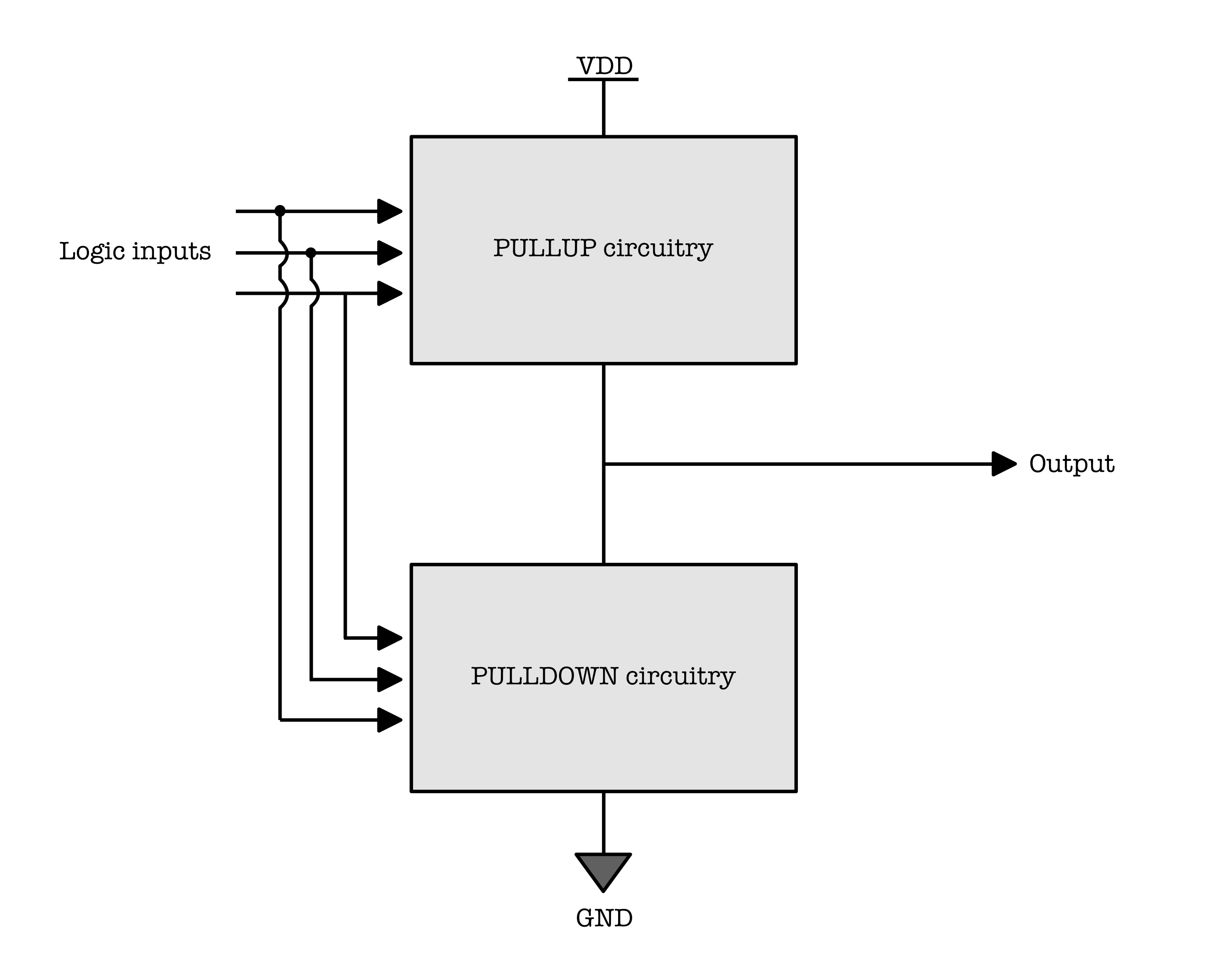
Contents of the pull-up circuit:
- All FETs in the pull-up circuit are PFETs.
- Hence all of their bulks are connected to the
VDD, and so are all of their Sources. - It is called ‘pull-up’ because when there is any open connection from the Source (
VDD) to the Drain output, then the output of the overall CMOS circuit is 1. - We call the pull-up circuit to be ON if there exists any direct path for current to flow from any source of the PFETs in the pull-up circuit to the logic output drain.
Contents of the pull-down circuit:
- All FETs in the pull-down circuit are NFETS.
- Hence all of their bulks are connected to
GND, and so are all of their Sources. - It is called ‘pull-down’ because when there is open connection to from the Source (
GND) to the Drain output, then the output of the overall CMOS circuit is 0 - We call the pull-down circuit to be ON if there exists any direct path for electrons to flow from any source of the NFETs in the pull-up circuit to the logic output drain.
The CMOS Complements Recipe
Imagine if pull-up and pull-down circuit (as an overall) are both “ON”. This means that there exists a direct open connection to GND from the VDD (the source of the pull-up to the source of the pull-down) resulting in short-circuit.
Hence, it is very important for a CMOS circuit to contain complementary pull-ups and pull-downs. This means that only one component – either pull-up or pull-down – is ON.
The main building blocks of the CMOS complements is summarized as below:
A combinational logic circuit can be made by connecting two NFETs in series as a pull-down circuit, and two PFETs in parallel as a pull-up circuit .
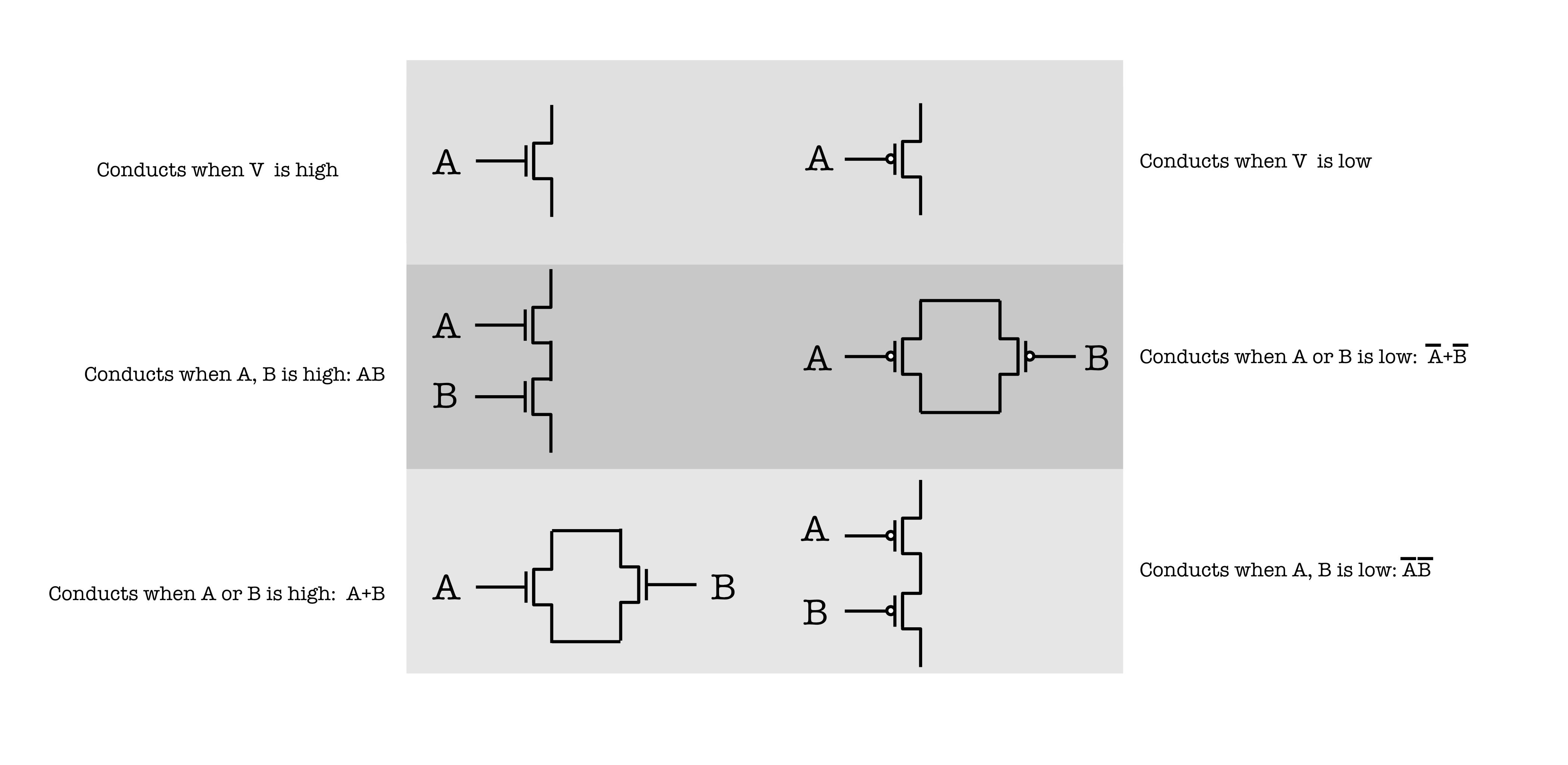
For example, the following is a CMOS circuitry for a NAND gate:
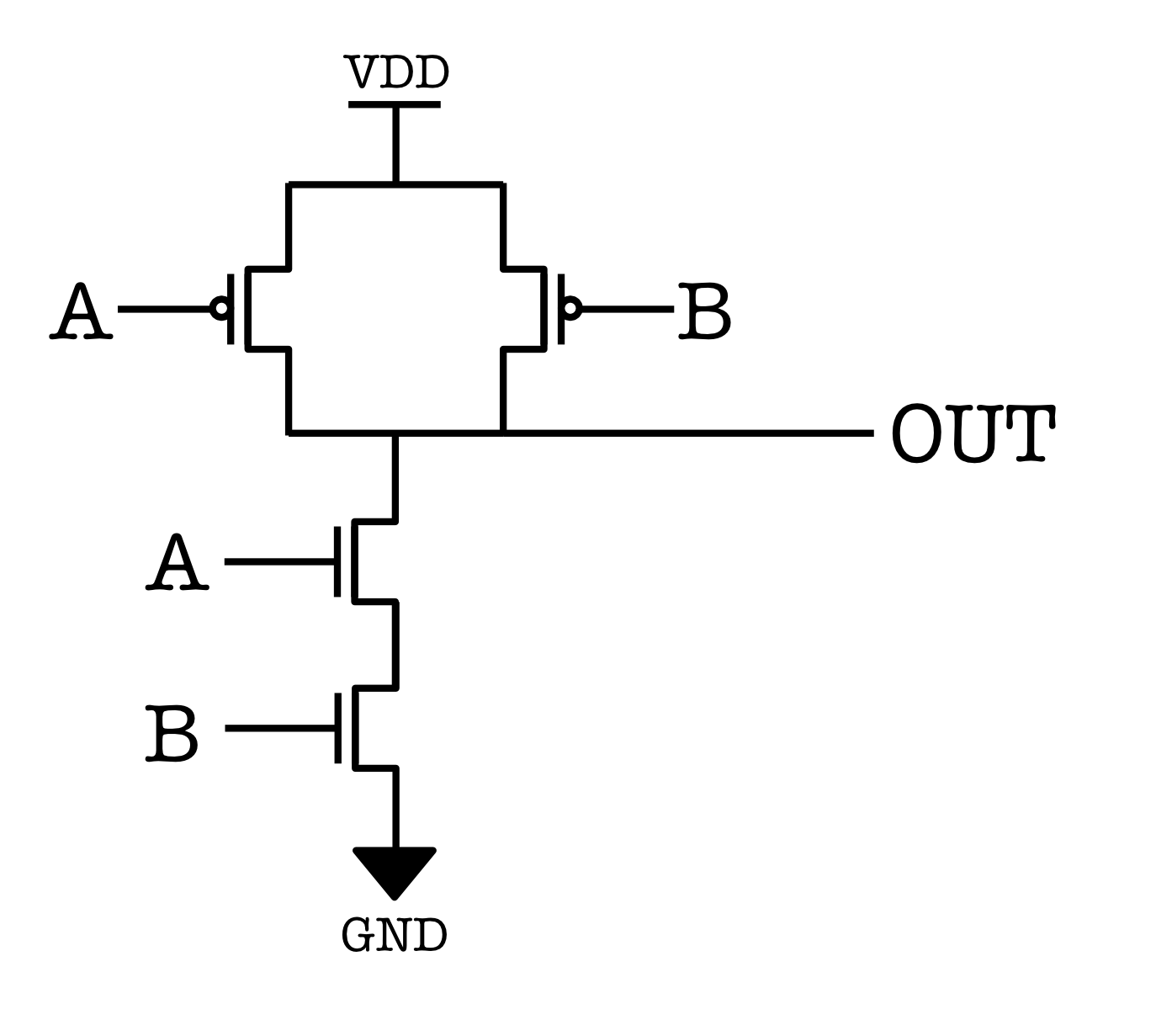
There are two inputs to this circuit, called A and B. A low or high voltage representing bit ‘0’ or bit ‘1’ respectively can be supplied to both input terminals. From the diagram, A is connected to the PFET on the left and the NFET on the top. B is connected to the PFET on the right and the NFET on the bottom.
Now we consider several cases. In Case 1, we consider what the output will be when A=1 and B=1. In Case 2, we consider what the output will be when A=0 and B=1. There are actually four cases, as shown on the truth table in the figure, but we will only discuss two here as we can easily extend the logic for the remaining cases.
Case 1:
- Lets see what happens when
A=1andB=1(both at high voltages that represent bit 1) - When
A=1, the PFET on the left is “OFF”, the NFET on the top is “ON” - When
B=1, the PFET on the right is “OFF” and the NFET on the bottom is “ON” - Current from
VDDcannot flow to the output through any of the left and the right PFET - Current at the output is drained down to the
GNDthrough both NFET on the top or NFET on the bottom. - Hence the output of the device is
0whenA=1andB=1
Case 2:
- Another case, when
A=0, andB=1(A at low voltage that represent bit0, and B at high voltage that represent bit1) - When
A=0, the PFET on the left is “ON”, the NFET on the top is “OFF” - When
B=1, the PFET on the right is “OFF” and the NFET on the bottom is “ON”. - This means there’s no connection between the output and the ground. However, current from
VDDcan still flow from the PFET on the left to the output. - Hence the output of the device is
1whenA=0andB=1
Notice how there’s parallel PFET in the pull-up, and series NFET in the pull-down.
This is exactly the recipe for CMOS complement, ensuring that there will be no combination of input that will cause both pull-up and pull-down circuits to be ON.
As practice, you can try to trace what happens when
A=0, B=0, and whenA=1, B=0and construct a truth table for this simple circuit.
Logic Gates
Notice how the circuitry in the previous section is called NAND. The name comes from this particular functional specification (truth table) of the combinational logic circuit.
A combinational device with multiple inputs but only one output is called a logic gate .
The NAND gate is just one of many possible gates that we will encounter in this course. We will learn that in the next notes.
Timing Specifications of Combinational Logic Devices
Recall that combinational devices have timing specifications that tells us the upper bound required propagation time to compute the specified output given a set of valid and stable input values.
Propagation Delay $t_{pd}$
So far we haven’t discussed about this term called propagation delay, which is specification that a combinational logic device must have.
The propagation delay, denoted as $t_{pd}$ is defined as follows:
Assume the output of a device is initially invalid. The propagation delay is the time taken for the device to produce a valid output, measured the moment it was given a valid input.
The effective $t_{pd}$ of an entire circuit is the maximum cumulative propagation delay over all paths from inputs to outputs in the combinational logic circuit.
The intuition behind why t$_{pd}$ is calculated as the maximum cumulative propagation delay over all paths:
- Each component (gates, made up of FETS in CMOS arrangements) in the combinational logic circuit must wait for one another to produce a valid overall output.
- All components have to produce valid results before final output (the last logic gate in the circuit) can be produced.
Contamination delay $t_{cd}$
Another timing specification that is typically measured an indicated on a combinational logic device is the contamination delay.
The contamination delay denoted as $t_{cd}$ is defined as follows:
Assume the output of a device is initially valid. The contamination delay is the time taken for the device to produce an invalid output, measured from the moment it was given an invalid input.
The effective $t_{cd}$ of an entire circuit is the minimum cumulative contamination delay over all paths from inputs to outputs in the combinational logic circuit.
The intuition behind why t$_{cd}$ is calculated as the minimum cumulative contamination delay over all paths:
- It takes the fastest route to propagate invalid signal and
- Finally contaminates ANY output (to be invalid, when it was initially valid).
Exercise
Complementary pull-up (made up of PFETs) and pull-down circuits (made up of NFETs) form a CMOS gate. With these gates, we can form a combinational logic circuit, example as shown:

Given the $t_{pd}$ and $t_{cd}$ for the NAND gate: $t_{pd} = 4 ns$, $t_{cd}=1ns$, we can find that:
- The overall $t_{pd}$ of the circuit is $12 ns$ (the path in red)
- The overall $t_{cd}$ of the circuit is $2 ns$ (the path in blue)
## Summary
We begin the chapter by understanding how a MOSFET can be used as the most basic building block (element) in digital circuits. There are two types of FETs, namely NFET and PFET, that can be “activated” (switched on) or “deactivated” (switched off) using proper voltages supplied at its gate.
It takes time for these FETs to work, e.g: reacting to the input voltage at its gate and establish a (low or high) voltage value at its drain. Therefore it is important to specify the timing specifications of a combinational logic device so that users may know how long the device takes to react (to a new valid input, or to an invalid input).
Note: knowing how long the combinational device takes to react (at most) tells us how often (e.g: at what rate) can we supply new inputs to the device, and how fast the device can process/compute a batch of input values.
We can assemble a few FETs to implement any truth table or Boolean functions (we will learn this more in next chapter), hence creating combinational logic devices. A specific type of combinational logic devices that has one output bit is called as gate. There are many types of gates, depending on the Boolean function that’s realised. Then, an even larger combinational logic circuits (that realises more complicated Boolean functions) can be created by assembling many of these gates together.
You will try this in Lab 2, where you are tasked to build an combinational logic circuit called the adder.
 Computation Structures
Computation Structures